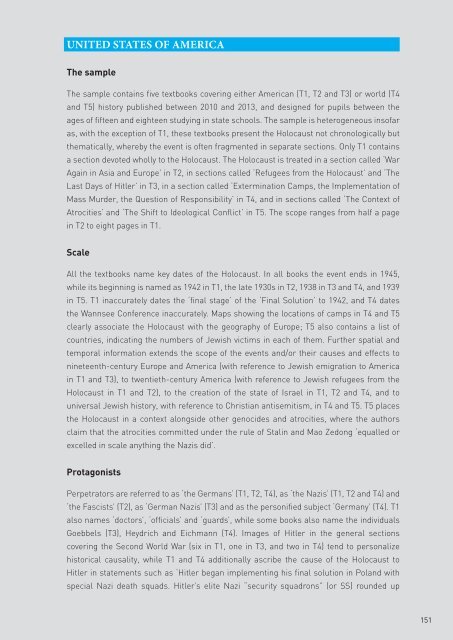228776e
228776e
228776e
Create successful ePaper yourself
Turn your PDF publications into a flip-book with our unique Google optimized e-Paper software.
UNITED STATES OF AMERICA<br />
The sample<br />
The sample contains five textbooks covering either American (T1, T2 and T3) or world (T4<br />
and T5) history published between 2010 and 2013, and designed for pupils between the<br />
ages of fifteen and eighteen studying in state schools. The sample is heterogeneous insofar<br />
as, with the exception of T1, these textbooks present the Holocaust not chronologically but<br />
thematically, whereby the event is often fragmented in separate sections. Only T1 contains<br />
a section devoted wholly to the Holocaust. The Holocaust is treated in a section called ‘War<br />
Again in Asia and Europe’ in T2, in sections called ‘Refugees from the Holocaust’ and ‘The<br />
Last Days of Hitler’ in T3, in a section called ‘Extermination Camps, the Implementation of<br />
Mass Murder, the Question of Responsibility’ in T4, and in sections called ‘The Context of<br />
Atrocities’ and ‘The Shift to Ideological Conflict’ in T5. The scope ranges from half a page<br />
in T2 to eight pages in T1.<br />
Scale<br />
All the textbooks name key dates of the Holocaust. In all books the event ends in 1945,<br />
while its beginning is named as 1942 in T1, the late 1930s in T2, 1938 in T3 and T4, and 1939<br />
in T5. T1 inaccurately dates the ‘final stage’ of the ‘Final Solution’ to 1942, and T4 dates<br />
the Wannsee Conference inaccurately. Maps showing the locations of camps in T4 and T5<br />
clearly associate the Holocaust with the geography of Europe; T5 also contains a list of<br />
countries, indicating the numbers of Jewish victims in each of them. Further spatial and<br />
temporal information extends the scope of the events and/or their causes and effects to<br />
nineteenth-century Europe and America (with reference to Jewish emigration to America<br />
in T1 and T3), to twentieth-century America (with reference to Jewish refugees from the<br />
Holocaust in T1 and T2), to the creation of the state of Israel in T1, T2 and T4, and to<br />
universal Jewish history, with reference to Christian antisemitism, in T4 and T5. T5 places<br />
the Holocaust in a context alongside other genocides and atrocities, where the authors<br />
claim that the atrocities committed under the rule of Stalin and Mao Zedong ‘equalled or<br />
excelled in scale anything the Nazis did’.<br />
Protagonists<br />
Perpetrators are referred to as ‘the Germans’ (T1, T2, T4), as ‘the Nazis’ (T1, T2 and T4) and<br />
‘the Fascists’ (T2), as ‘German Nazis’ (T3) and as the personified subject ‘Germany’ (T4). T1<br />
also names ‘doctors’, ‘officials’ and ‘guards’, while some books also name the individuals<br />
Goebbels (T3), Heydrich and Eichmann (T4). Images of Hitler in the general sections<br />
covering the Second World War (six in T1, one in T3, and two in T4) tend to personalize<br />
historical causality, while T1 and T4 additionally ascribe the cause of the Holocaust to<br />
Hitler in statements such as ‘Hitler began implementing his final solution in Poland with<br />
special Nazi death squads. Hitler’s elite Nazi “security squadrons” (or SS) rounded up<br />
151




